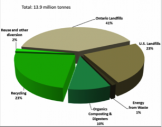The Province of Ontario is preparing to implement a “cap-and-trade” policy for Ontario’s greenhouse gas (GHG) emissions. Ontario’s waste management industry influences Ontario’s greenhouse gas emissions in a number of ways, including direct and obvious sources of emissions like landfill gas emissions and the tailpipe emissions from its fleet of heavy trucks, but it also makes an enormous positive contribution to limiting greenhouse gas emissions. Every year, industry activities reduce current and future greenhouse gas emissions in Ontario by 22 million tonnes CO2eq, 14 Mt CO2eq more than the 8 Mt CO2eq of landfill gas emissions from the legacy waste-in-place in all Ontario landfills. Even so, landfill gas capture, recycling and organic waste diversion rates are still relatively low and will need to increase dramatically for the province to meet its emission reduction targets and make the transition to a sustainable, low carbon and circular economy.
The waste management industry is well positioned to access the substantial regulatory value that will be created by the cap on carbon, through the creation of offset protocols that facilitate growth in landfill gas capture and organics diversion, through partnerships with capped emitters who will value the carbon-free energy generated at waste management facilities, through investment in efficiency and low carbon alternatives in their own operations, and through creative partnerships with government for the direct investment of allowance auction revenue in building the foundation for the circular economy.
